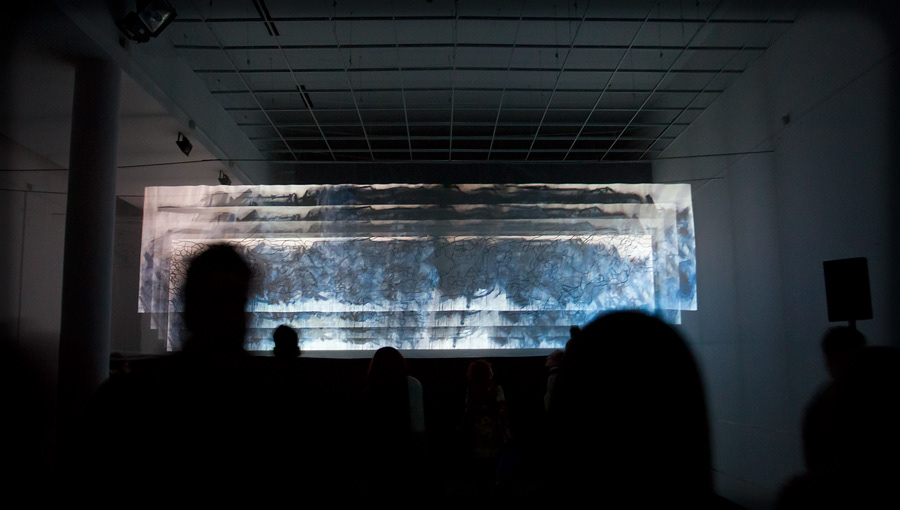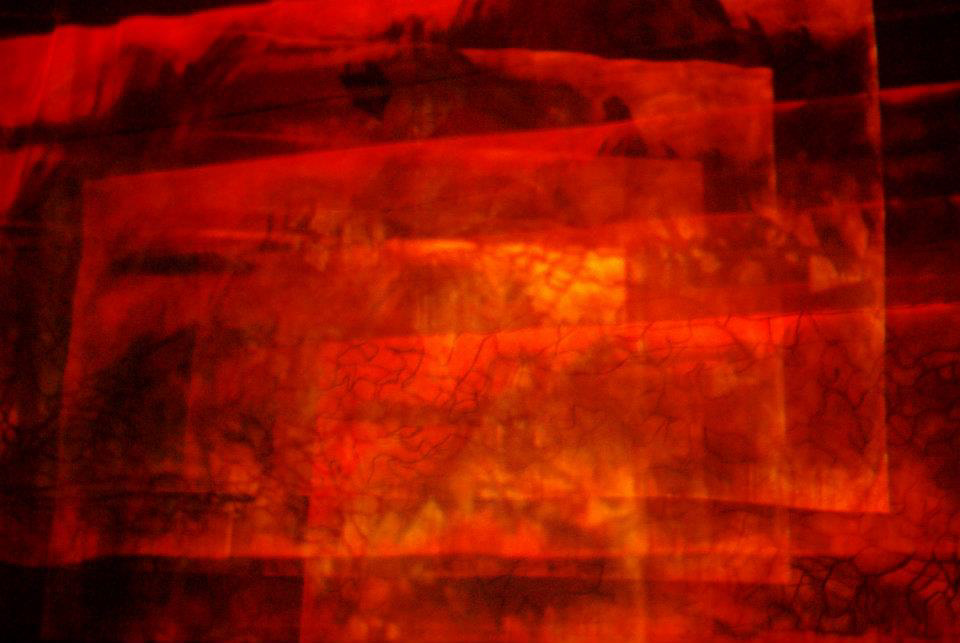
The project I created was conceived as a space- ambient installation, through which I striveto show multiple layers my work consists of. An installation is not just a bear assembly ofobjects but a space-dependent relation of many objects between which a separate, specialspace exists. The work itself is conceived as an ambient presentation whose inner sideconsists of a compliance of different separate entities. More precisely, it is divided into threeseparate layers/spaces and one inner-space, that consists of nine canvases on which willsome of the layers and spaces, holding the observer himself, be projected.







The frontal space is being presented in the form of a painting (size 850 x 200 cm) and it isset up at the left side of the gallery. This space, as an existing space, stands as a symbol ofthe exterior cover of an inner truth-the drawing. It conceals by revealing, and reveals byconcealing. The surface of this painting is only the current, final layer of my visual artwork.
The whole painting consists of 53 layers. The first layer, a linear drawing, is being displayedat the opposite side of the gallery. The between-space, that is not suitable for materialisation,is being presented in the form of a video artwork. This space is divided into two parts:the first one comprises one – third of the space and is designated for the observer, and therest consists of nine canvases (size 859 x 200 cm), on which will the layers be projected.This space is designated only for people who have a desire to find out more. My objectiveis to present the process and the “game” of creating a work of art, which usually remainsundiscovered. I have spread one thin layer of colours, seen from the non frontal side of thepainting in order to amplify the spatial relations of a visual work of art. Those numerousspaces between the layers can not be seen from the side, because the observer is onlyallowed to watch from the front. However, in spite of this, the observer has the possibility ofgetting to the essence of the work.
The whole painting consists of 53 layers. The first layer, a linear drawing, is being displayedat the opposite side of the gallery. The between-space, that is not suitable for materialisation,is being presented in the form of a video artwork. This space is divided into two parts:the first one comprises one – third of the space and is designated for the observer, and therest consists of nine canvases (size 859 x 200 cm), on which will the layers be projected.This space is designated only for people who have a desire to find out more. My objectiveis to present the process and the “game” of creating a work of art, which usually remainsundiscovered. I have spread one thin layer of colours, seen from the non frontal side of thepainting in order to amplify the spatial relations of a visual work of art. Those numerousspaces between the layers can not be seen from the side, because the observer is onlyallowed to watch from the front. However, in spite of this, the observer has the possibility ofgetting to the essence of the work.
















The pre-existing space is the one which is embraced by the drawing. The essential ideasurrounding the drawing is for it to take us to the metaphysical world of ideas. The artist isthe only one who can enter that world, clasp the ideas and transfer them to the drawing. Hecan accomplish that only by using symbols and the observer is the one who has the missionof discovering their true meaning. In order to prove this I will illuminate the space with afire-like light. Fire is the only substance that is always equal to itself, the only that containsits own light, and the only that has the power of producing light and burning. This takesus to the conclusion that the essence of the pre-existing space is God, because he makeseverything visible. The light is important because it breaks the darkness of a closed space.With illuminating a drawing we make comprehension possible because the light enables usto get to the core of the drawing without thinking.





Another component of my work, besides the drawing, painting and light, is sound withwhich I want to draw the attention to the power of music to create or destroy. My interestfor creating a sound installation was developed after becoming familiar with the musicof Karlheinz Stockhausen, one of the most important composers of the twentieth century.The music he wrote was exceptionally difficult to listen to, from time to time absurdlypretentious in its endeavours to be greater than what reality has to offer. While exploring hiswork, I noticed that a music composition consists of layers and decided to merge the layersof the sound I have been hearing. Those sounds were not the sounds of the outer word butthe sounds coming from inside myself. What I wanted to achieve with all this, besides theintimate opening of my work, is for the observer to see the real me by using his senses.






The sound inside my installation represents a synthesis of silence, boring, irritating soundI hear every time I am about to doze off to sleep and the sounds that induced me to createcertain layers of my work. It is arduous, agonizing, the same as the path I took in order tocreate my work and I introduced it in order to carry out an experiment. I wanted to see howthe observers would react, would they be repulsed or would they be encouraged to approachthe work.








The obsession to behold my work as a whole drove me to the conclusion that it is only thelight that enables us to comprehend a work of art as a whole. The lightened form createsthe idea about an outer cover, a cover that guards the inner truth-the drawing. The threelayers inside the installation are connected in a logical way, one after another. The workis defined by the layout of objects, meaningful articulation of the whole and the totalityof space. The installation will have features of a group visual work of art, because it willbring together different phenomena such as space, light, sound and the motion of theobserver. The established unity in the relation between objects represents harmony. Also themonumentality of the installation becomes necessary in order to draw in the observer andkeep him occupied in a world of countless information.




The objective of this research is to question the logic of the reality of space, and with thatpoint to the notion about a different reality. By dismantling the layers of a visual work of artI want to place the attention to the way it exists in, how do relations inside it function andhighlight the drawing as its essence. Actually, my project is very much like a hiding-placeand with the opening of that hiding place I am opening myself, as well. By presenting thespace in-between I want to show that the being itself consists of layers and I see this projectas a strong alliance between thoughts and drawings, which has a power over reality. Thedrawing is created with me being present in it in the moment of its creation.


































